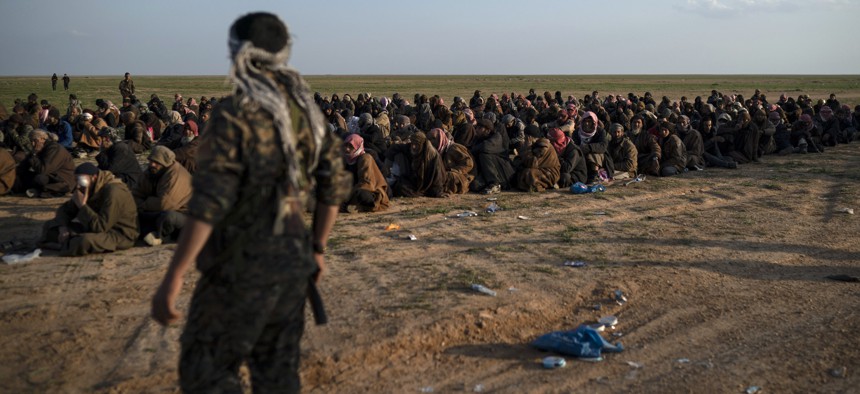
FILE - In this Feb. 22, 2019 file photo, U.S.-backed Syrian Democratic Forces (SDF) fighters stand guard next to men waiting to be screened after being evacuated out of the last territory held by Islamic State group militants, near Baghouz, eastern Syria. AP Photo
A ‘Mass Breakout’ of ISIS from Syrian Prisons Remains a Risk, Pentagon Watchdog Says
The coalition has had “little or no direct access” to the facilities since Turkey’s October invasion.
Thousands of ISIS fighters held by the Syrian Democratic Forces in Syria continue to pose a “high-impact risk of a mass breakout” — but since the U.S. withdrawal from northeastern Syria, U.S. forces do not have access to the prison facilities to assess the severity of that risk, the Pentagon’s inspector general warned in a report released Wednesday.
“If not adequately addressed, these populations of fighters pose one of the most significant risks to the success of the [anti-ISIS] mission, in addition to posing a threat to U.S. and Coalition partner national security,” the U.S.-led mission in Iraq and Syria reported to the lead inspector general, Sean O’Donnell.
Since Turkish forces invaded northeastern Syria in October, the coalition has “little or no direct access” to the facilities and “is no longer able to track comprehensive data on the foreign fighter population or the level of security at the SDF detention centers where they are being held,” the report said. The coalition’s knowledge of the situation relies solely on information from the SDF.
Ongoing riots and small-scale escape attempts “underscore the risk,” the report found, although the U.S. mission reported that it found no change this quarter in the SDF’s ability to maintain the detention centers. (It also reported no improvements in perimeter security.)
Ever since President Trump decided last fall to withdraw troops in the face of Turkey’s imminent incursion, senior U.S. national security officials have harbored fears that thousands of ISIS fighters held in the SDF’s makeshift prisons will break free. There were reports of small numbers of fighters escaping during the invasion, and a March 29 riot at a detention center at Hasakah raged for 24 hours before the SDF was able to quell it. The inspector general cited media reports that “ISIS militants began breaking down doors and digging holes in walls between cells.”
“The rioting was brought under control the next morning, but erupted again with gunfire heard inside and ambulances called in to help the wounded,” the report said.
Dozens of fighters are crammed in a single cell, security cameras don’t work or aren’t available, and cheap cement walls are crumbling, officials who have visited the prisons say. Although the United States has provided money to help pay for security upgrades and training, the SDF has pleaded for more support to help hold the fighters and put down riots and escape attempts.
The SDF currently holds about 2,000 foreign fighters and about 8,000 Syrian and Iraqi fighters, according to the report. Although the U.S. and the UN have urged nations to repatriate their fighters, domestic political and legal concerns have kept many nations from agreeing and, in some cases, have led countries to strip ISIS fighters of their citizenship. The problem of what to do with these fighters has remained intractable, and although the SDF has remained committed to holding the detainees, “officials said that the longer the foreign fighters were held, the more they become radicalized, and the greater potential for them to organize breakouts,” the report warned.
The risk of escapes drew much of the Western media attention during the Turkish invasion; critics argued that Trump had paved the way for potential breakouts by not doing more to stop Ankara. At the time, the SDF promoted false accounts about Kurdish prison guards leaving their posts at the prisons to fight along the Turkish border.
The stories, an SDF spokesman told the New Yorker, “made the international community pay attention."




